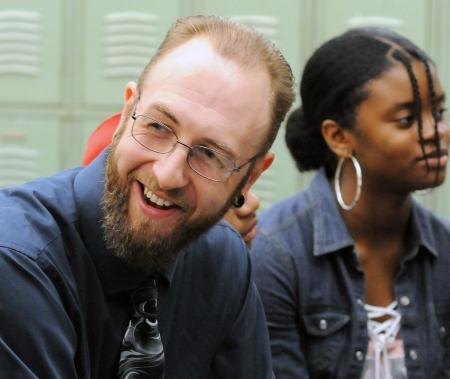
Restorative justice practives such as circles have helped Ryan Wozniak create a sense of family among his students.
When I began my career as a high school social studies teacher four years ago, I knew I wanted my classroom management to be dramatically different from the “reward and punishment” style. I developed a blueprint for working with my students instead of needing to manage them: teaching the whole person, embodying an ethics of care, developing students’ social-emotional skills, being culturally responsive and building community via restorative justice practices.
For four years, my students’ first homework assignment has been to complete a 25-question personal inventory. Questions range from their strengths to their bad habits to their feelings about school in general.
As I read each of the inventories, the names I have read off the attendance rosters those first few days of the new school year begin to develop into much deeper, richer and authentic composites of each one of my students. This information is invaluable for building relationships, creating community and connecting new content to culturally relevant examples from students’ everyday lives.
When we know who our students are and are able to speak to their interests, we will see exponential increases in their motivation and their cognitive abilities.
The work of knowing my students and building relationships does not end with reading their personal inventories. By early November, I make it a point to have had personal interactions with all of my students — one on one or in groups of two to three — in order to engage in empathy interviews. I ask neutral and open-ended questions: How is school going? Do you have a favorite class this school year? How’s life outside of school? Who are your favorite teachers?
In these interviews, I encourage students to reflect and provide authentic responses to my questions. I never guide students back to a specific or narrow topic; instead I may say, “Yes, and…” to encourage students to tell me their stories.
My high school was lucky enough to be in one of the first high school districts to pilot restorative justice practices. Using restorative justice practices such as circles has been a huge part of building community, collective efficacy and a sense of family not only in my classroom, but throughout my school. Bringing students, teachers and staff into circles to overcome obstacles or work through emotional or behavioral struggles has proven to be much more effective than traditional punitive methods.
I’ve also made it a point to engage in self-reflection about my pedagogical practices and my own biases and to practice social-emotional awareness and mindfulness. I am a heterosexual white man who attended predominately white schools in the suburbs of Long Island; almost all of my students are young people of color in Brooklyn. Practicing culturally responsive pedagogy entails more than merely knowing our students; it is about realizing, as historian Howard Zinn once said, “We can’t be neutral on a moving train.” One strategy I’ve used is to keep a journal to reflect on, document and track my development and strengthen my connection with my values.
Lastly, I make it a point to be myself in front of my students. By sharing my story of struggle and success, admitting when I don’t know something, apologizing for mistakes I make and highlighting my imperfections, I make myself vulnerable to my students and make myself more human. I have found this level of transparency with my students is extremely effective in cultivating their trust.